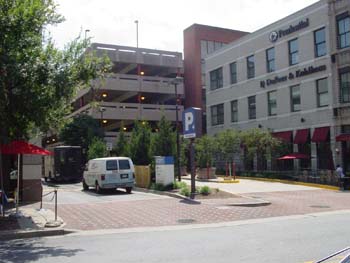When you create parking districts, they only focus on parking

Center of the block parking garage at Bethesda Row, Bethesda, Maryland. Usually parking at night and on weekends is free. People park, and then walk around the 3+ blocks of the commercial district. There is a Barnes & Noble, movie theater, and many many many restaurants.
When you create "Transportation Management Districts," then the organization rightly focuses on all transportation modes. I was really struck by this, reading about the creation of a Parking Management District in Manayunk, Philadelphia, in the book Paths and pitfalls - on the way to a new vibrancy in older retail districts by Ed Crow. Manayunk is served by buslines and regional rail, but the PMD there focused completely on parking lots.
Greater Greater Washington, in "Fund Ride-On, not subsidized parking, says Transit First," shows an example of similarly limited thinking in nearby Montgomery County. Granted that in Bethesda and Silver Spring, MoCo has transportation districts, however because of the way that the parking district is created and how parking ticket revenue supports the parking garages, not all transportation modes, policies tend to promote automobility rather than more balanced transportation choices.
In "Parking district plan is half of the solution" in the Gazette, last year I wrote about overly constrained thinking.
Labels: parking, transportation demand management, transportation planning



0 Comments:
Post a Comment
<< Home